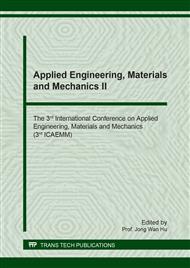p.171
p.179
p.184
p.189
p.196
p.202
p.208
p.214
p.220
Shear Strength and Fracture Location of Dissimilar A6063 Aluminum Alloy and SUS430 Stainless Steel Lap Joint
Abstract:
In this paper, friction stir welding (FSW) was used to weld the dissimilar A6063 Aluminum/SUS430 stainless steel lap joint with various parameter setting in a welding process. The setting included a rotating speed between 125-750 rpm, a welding speed between the 25-175 mm/min and 0-5 degrees of tool tilted angle. The welded lap joints were systematically examined in regard of the tensile-shear strength, the fracture path, and microstructure. The experimental results were concluded as follows. The decrease in the welding heat input generated from the low rotating speed and the high welding resulted in decreasing of the shear strength. A degree of a tool tilted angle affected a shear strength, and a change in the strength came from the different rate in material combination at the joint interface. The increase in a tensile-shear strength occurred for specimens produced in 0-2 degrees of a tool tilted angle while 3-5 degrees affected in decreasing. The highest shear strength of 11,870 N was obtained when the lap joint was produced by the rotating speed of 500 rpm, the welding speed of 50 mm/min and the tool tilted angle at 2 degrees. The fracture path found in the specimen with the maximum shear strength was located in the Al stirred zone, not in the joint interface.
Info:
Periodical:
Pages:
196-201
Citation:
Online since:
July 2018
Authors:
Price:
Сopyright:
© 2018 Trans Tech Publications Ltd. All Rights Reserved
Share:
Citation:


